Advancing the Solar Radiation Pressure Model for BeiDou-3 IGSO Satellites
Abstract
:1. Introduction
2. Materials and Methods
2.1. ECOM-Type Models
2.2. Box-Wing Model
2.3. BeiDou-3 IGSOs’ Structure
3. Results
3.1. BeiDou-3 IGSO Optical Properties Estimates
3.2. Performance of SRP Models for BeiDou-3 IGSO Satellites
3.2.1. Orbit Assessment Based on Estimated Clocks
3.2.2. Orbit Assessment Based on Orbit Boundary Discontinuities
4. Discussion
Author Contributions
Funding
Institutional Review Board Statement
Informed Consent Statement
Data Availability Statement
Acknowledgments
Conflicts of Interest
References
- Yang, Y.; Mao, Y.; Sun, B. Basic performance and future developments of BeiDou global navigation satellite system. Satell. Navig. 2020, 1, 1. [Google Scholar] [CrossRef] [Green Version]
- China Satellite Navigation Office. Development of the BeiDou Navigation Satellite System (Version 3.0). Available online: http://www.beidou.gov.cn/xt/gfxz/201812/P020190117356387956569.pdf (accessed on 8 March 2020).
- Ruan, R.; Jia, X.; Feng, L.; Zhu, J.; Hu, Y.; Li, J.; Wei, Z. Orbit determination and time synchronization for BDS-3 satellites with raw inter-satellite link ranging observations. Satell. Navig. 2020, 1, 8. [Google Scholar] [CrossRef] [Green Version]
- Wang, W.; Wang, Y.; Yu, C.; Xu, F.; Dou, X. Spaceborne atomic clock performance review of BDS-3 MEO satellites. Measurement 2021, 175, 109075. [Google Scholar] [CrossRef]
- Shi, C.; Zhao, Q.; Li, M.; Tang, W.; Hu, Z.; Lou, Y.; Zhang, H.; Niu, X.; Liu, J. Precise orbit determination of Beidou Satellites with precise positioning. Sci. China-Earth Sci. 2012, 55, 1079–1086. [Google Scholar] [CrossRef]
- Shi, C.; Zhao, Q.; Liu, J. Precise relative positioning using real tracking data from COMPASS GEO and IGSO satellites. GPS Solut. 2013, 17, 103–119. [Google Scholar] [CrossRef]
- Fliegel, H.F.; Gallini, T.E.; Swift, E.R. Global positioning system radiation force model for geodetic applications. J. Geophys. Res. Solid Earth 1992, 97, 559–568. [Google Scholar] [CrossRef]
- Beutler, G.; Brockmann, E.; Gurtner, W.; Hugentobler, U.; Mervart, L.; Rothacher, M.; Verdun, A. Extended orbit modeling techniques at the CODE processing center of the International GPS Service for Geodynamics (IGS): Theory and initial results. Manuscr. Geod. 1994, 19, 367–386. [Google Scholar]
- Montenbruck, O.; Steigenberger, P.; Hugentobler, U. Enhanced solar radiation pressure modeling for Galileo satellites. J. Geod. 2015, 89, 283–297. [Google Scholar] [CrossRef]
- Yuan, Y.; Li, X.; Zhu, Y.; Xiong, Y.; Huang, J.; Wu, J.; Li, X.; Zhang, K. Improving QZSS precise orbit determination by considering the solar radiation pressure of the L-band antenna. GPS Solut. 2020, 24, 50. [Google Scholar] [CrossRef]
- Arnold, D.; Meindl, M.; Beutler, G.; Dach, R.; Schaer, S.; Lutz, S.; Prange, L.; So’snica, K.; Mervart, L.; Jäggi, A. CODE’s new solar radiation pressure model for GNSS orbit determination. J. Geod. 2015, 89, 775–791. [Google Scholar] [CrossRef] [Green Version]
- Prange, L.; Orliac, E.; Dach, R.; Arnold, D.; Beutler, G.; Schaer, S.; Jäggi, A. CODE’s five-system orbit and clock solution—the challenges of multi-GNSS data analysis. J. Geod. 2016, 91, 345–360. [Google Scholar] [CrossRef] [Green Version]
- Wang, C. Solar Radiation Pressure Modelling for BeiDou Navigation Satellites. Ph.D. Dissertation, GNSS Research Center, Wuhan University, Wuhan, China, 2019. [Google Scholar]
- Yan, X.; Liu, C.; Huang, G.; Zhang, Q.; Wang, L.; Qin, Z.; Xie, S. A priori solar radiation pressure model for BeiDou-3 MEO satellites. Remote Sens. 2019, 11, 1605. [Google Scholar] [CrossRef] [Green Version]
- Dilssner, F.; Springer, T.; Schönemann, E.; Enderle, W. Recent Advances in Galileo and BeiDou Precise Orbit Determination at ESA’s Navigation Support Office; EGU: Vienna, Austria, 2020; Available online: https://presentations.copernicus.org/EGU2020/EGU2020-18361_presentation.pdf (accessed on 20 November 2021).
- Rodriguez-Solano, C.; Hugentobler, U.; Steigenberger, P. Adjustable box-wing model for solar radiation pressure impacting GPS satellites. Adv. Space Res. 2012, 49, 1113–1128. [Google Scholar] [CrossRef]
- China Satellite Navigation Office. BeiDou Satellite Metadata. Available online: http://en.beidou.gov.cn/SYSTEMS/Officialdocument/201912/P020200323536298695483.zip (accessed on 8 March 2021).
- Wang, C.; Guo, J.; Zhao, Q.; Liu, J. Empirically derivedmodel of solar radiation pressure for BeiDou GEO satellites. J. Geod. 2018, 93, 791–807. [Google Scholar] [CrossRef]
- Duan, B.; Hugentobler, U.; Hofacker, M.; Selmke, I. The adjusted optical properties for Galileo/BeiDou-2/QZS-1 satellites and initial results on BeiDou-3e and QZS-2 satellites. Adv. Space Res. 2019, 63, 1803–1812. [Google Scholar] [CrossRef]
- Rodriguez-Solano, C.J.; Hugentobler, U.; Steigenberger, P.; Allende-Alba, G. Improving the orbits of GPS block IIA satellites during eclipse seasons. Adv. Space Res. 2013, 52, 1511–1529. [Google Scholar] [CrossRef]
- Duan, B.; Hugentobler, U.; Hofacker, M.; Selmke, I. Improving solar radiation pressure modeling for GLONASS satellites. J. Geod. 2020, 94, 72. [Google Scholar] [CrossRef]
- Sidorov, D.; Dach, R.; Prange, L.; Jäggi, A. Advancing the Orbit Model for Galileo Satellites during the Eclipse Seasons; EGU General Assembly: Vienna, Austria, 2018; Available online: https://boris.unibe.ch/116170/1/DS_EGU2018.pdf (accessed on 10 November 2020).
- Sidorov, D.; Dach, R.; Polle, B.; Prange, L.; Jäggi, A. Adopting the empirical CODE orbit model to Galileo satellites. Adv. Space Res. 2020, 66, 2799–2811. [Google Scholar] [CrossRef]
- Dach, R.; Schaer, S.; Arnold, D.; Orliac, E.; Prange, L.; Susˇnik, A.; Villiger, A.; Maier, A.; Mervart, L.; Jäggi, A.; et al. CODE Analysis Center Technical Report. In International GNSS Service Technical Report; Jean, Y., Dach, R., Eds.; University of Bern. IGS Central Bureau, Astronomical Institute, 2015; Available online: https://boris.unibe.ch/97576/8/Seiten%20aus%202015_techreport-2.pdf (accessed on 10 November 2020).
- Marshall, J.; Luthcke, S. Modeling radiation forces acting on TOPEX/Poseidon for precision orbit determination. J. Spacecr. Rocket. 1994, 31, 99–105. [Google Scholar] [CrossRef] [Green Version]
- Milani, A.; Nobili, A.M.; Farinella, P. Non-Gravitational Perturbations and Satellite Geodesy; Adam Hilger: Bristol, UK, 1987. [Google Scholar]
- Montenbruck, O.; Schmid, R.; Mercier, F.; Steigenberger, P.; Noll, C.; Fatkulin, R.; Kogure, S.; Ganeshan, A.S. GNSS satellite geometry and attitude models. Adv. Space Res. 2015, 56, 1015–1029. [Google Scholar] [CrossRef] [Green Version]
- Jiao, W.; Ding, Q.; Li, J.; Lu, X.; Feng, L.; Ma, J.; Chen, G. Monitoring and Assessment of GNSS Open Services. J. Navig. 2011, 64, S19–S29. [Google Scholar] [CrossRef]
- Montenbruck, O.; Steigenberger, P.; Prange, L.; Deng, Z.; Zhao, Q.; Perosanz, F.; Romero, I.; Noll, C.; Stürze, A.; Weber, G.; et al. The Multi-GNSS Experiment (MGEX) of the International GNSS Service (IGS)—Achievements, prospects and challenges. Adv. Space Res. 2017, 59, 1671–1697. [Google Scholar] [CrossRef]
- Liu, J.-N.; Ge, M.-R. PANDA software and its preliminary result of positioning and orbit determination. Wuhan Univ. J. Nat. Sci. 2003, 8, 603–609. [Google Scholar]
- Petit, G.; Luzum, B. (Eds.) IERS Conventions; Verlag des Bundesamts für Kartographie und Geodäsie: Frankfurt, Germany, 2010. [Google Scholar]
- Kouba, J. Notes on December 2017 Version of the ECLIPS Subroutine. Available online: http://acc.igs.org/orbits/eclips_Dec_2017.tar (accessed on 10 November 2020).
- Wang, C.; Guo, J.; Zhao, Q.; Liu, J. Yaw attitude modeling for BeiDou I06 and BeiDou-3 satellites. GPS Solut. 2018, 22, 117. [Google Scholar] [CrossRef]
- Ge, M.; Gendt, G.; Dick, G.; Zhang, F.P. Improving carrier-phase ambiguity resolution in global GPS network solutions. J. Geod. 2005, 79, 103–110. [Google Scholar] [CrossRef]
- Griffiths, J.; Ray, J. On the precision and accuracy of IGS orbits. J. Geod. 2009, 83, 277–287. [Google Scholar] [CrossRef]
- Dilssner, F.; Springer, T.; Gienger, G.; Dow, J. The GLONASS-M satellite yaw-attitude model. Adv. Space Res. 2011, 47, 160–171. [Google Scholar] [CrossRef]
- Prange, L.; Villiger, A.; Sidorov, D.; Schaer, S.; Beutler, G.; Dach, R.; Jäggi, A. Overview of CODE’s MGEX solution with the focus on Galileo. Adv. Space Res. 2020, 66, 2786–2798. [Google Scholar] [CrossRef]
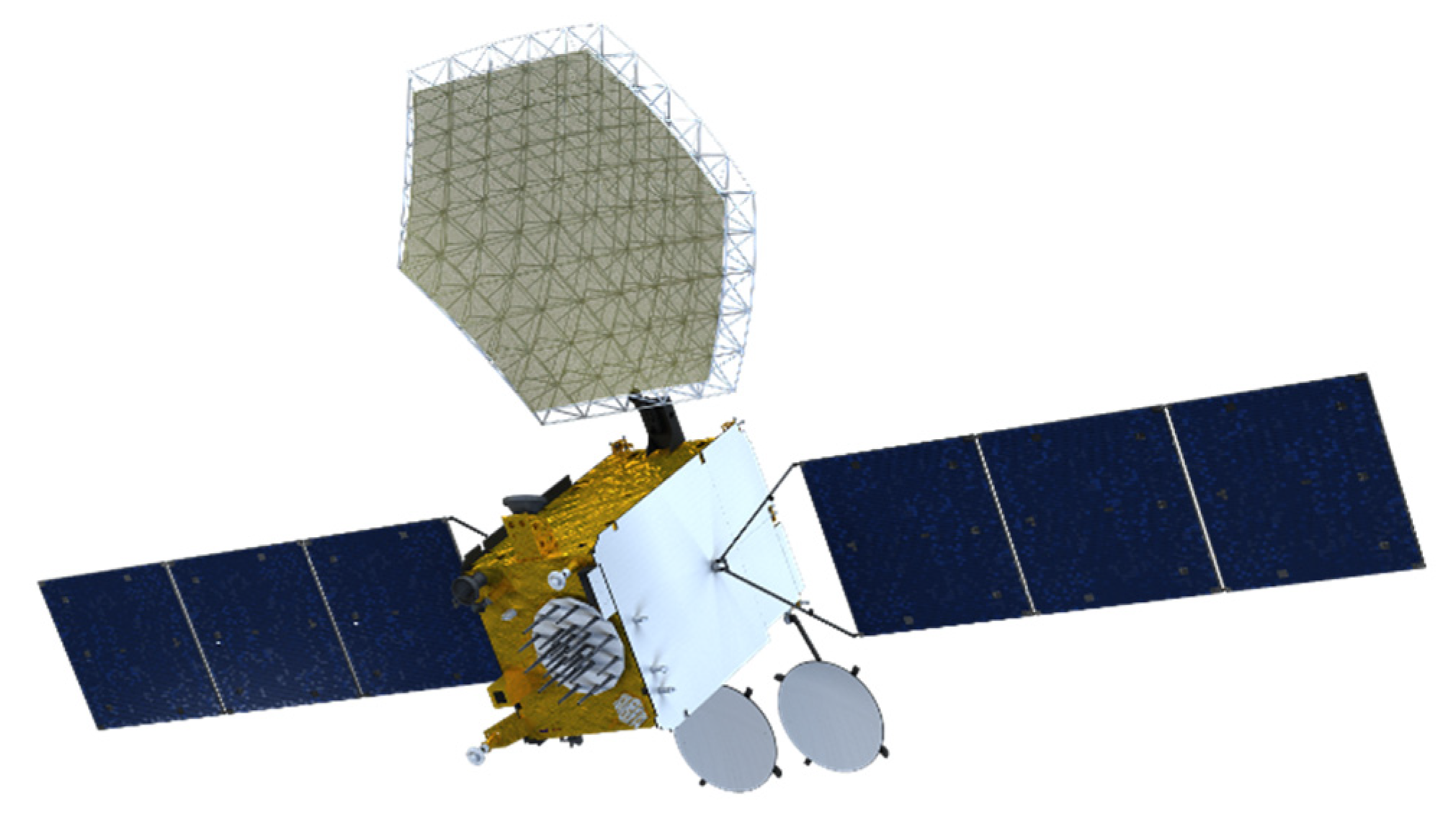
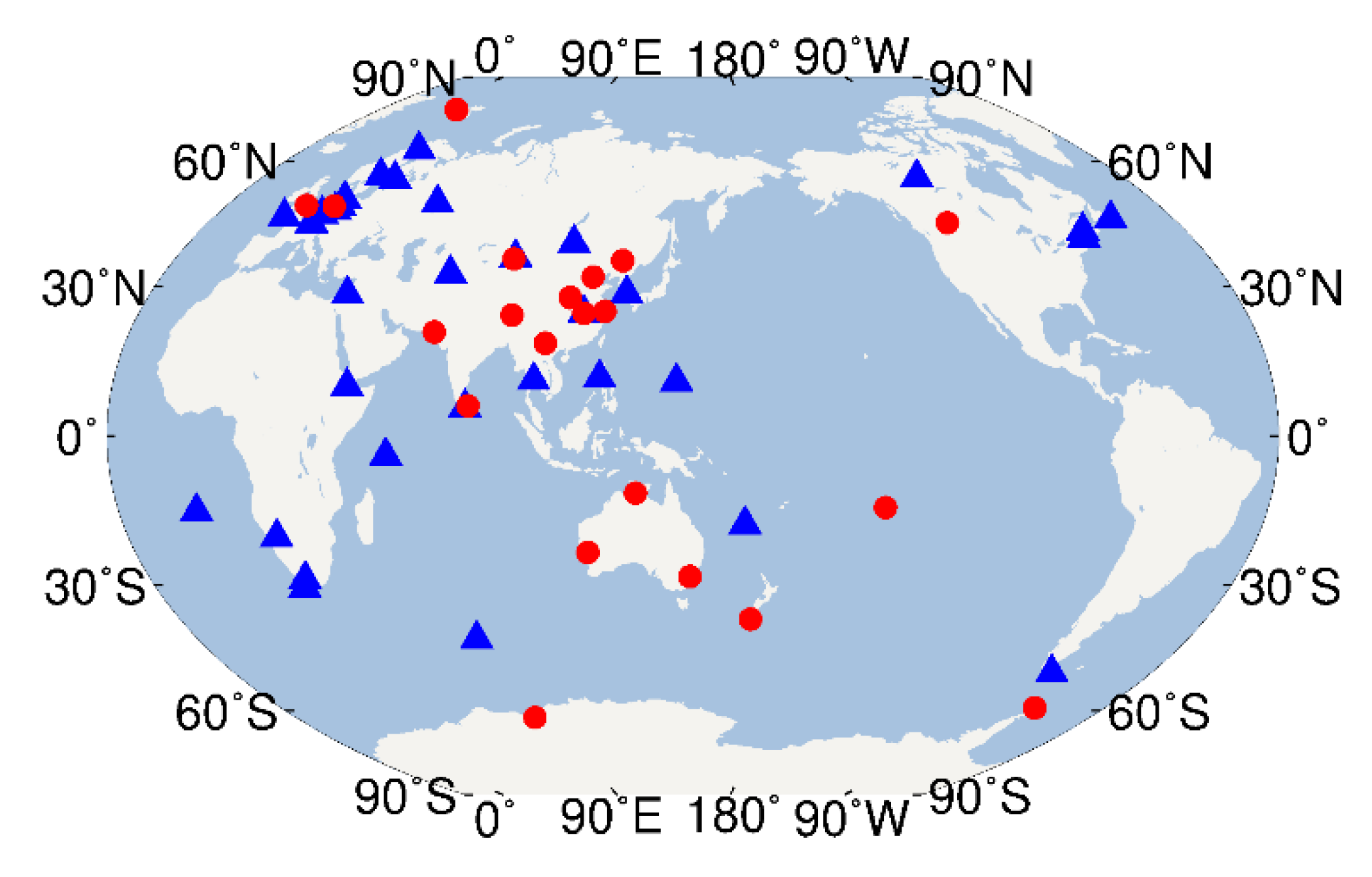
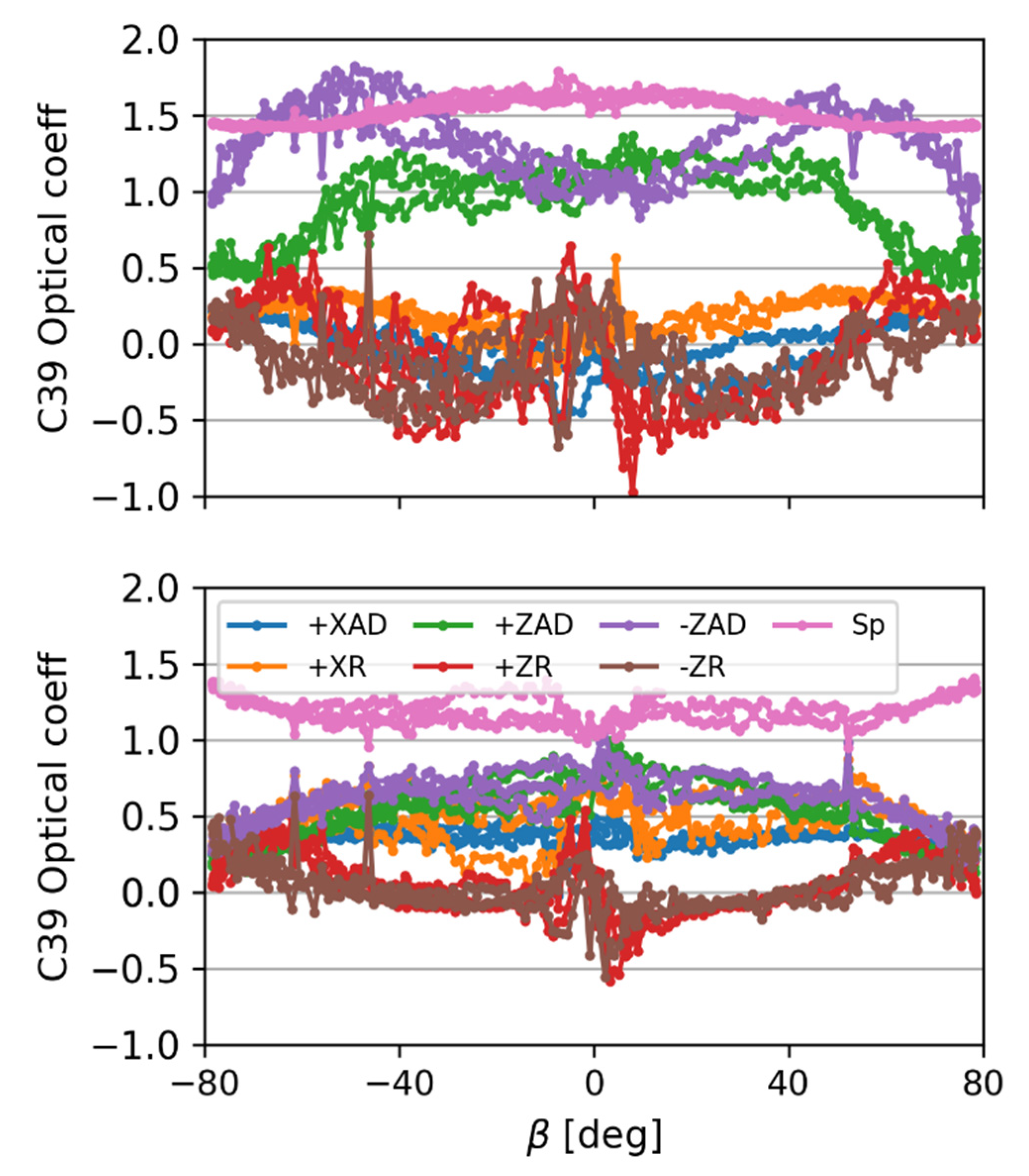
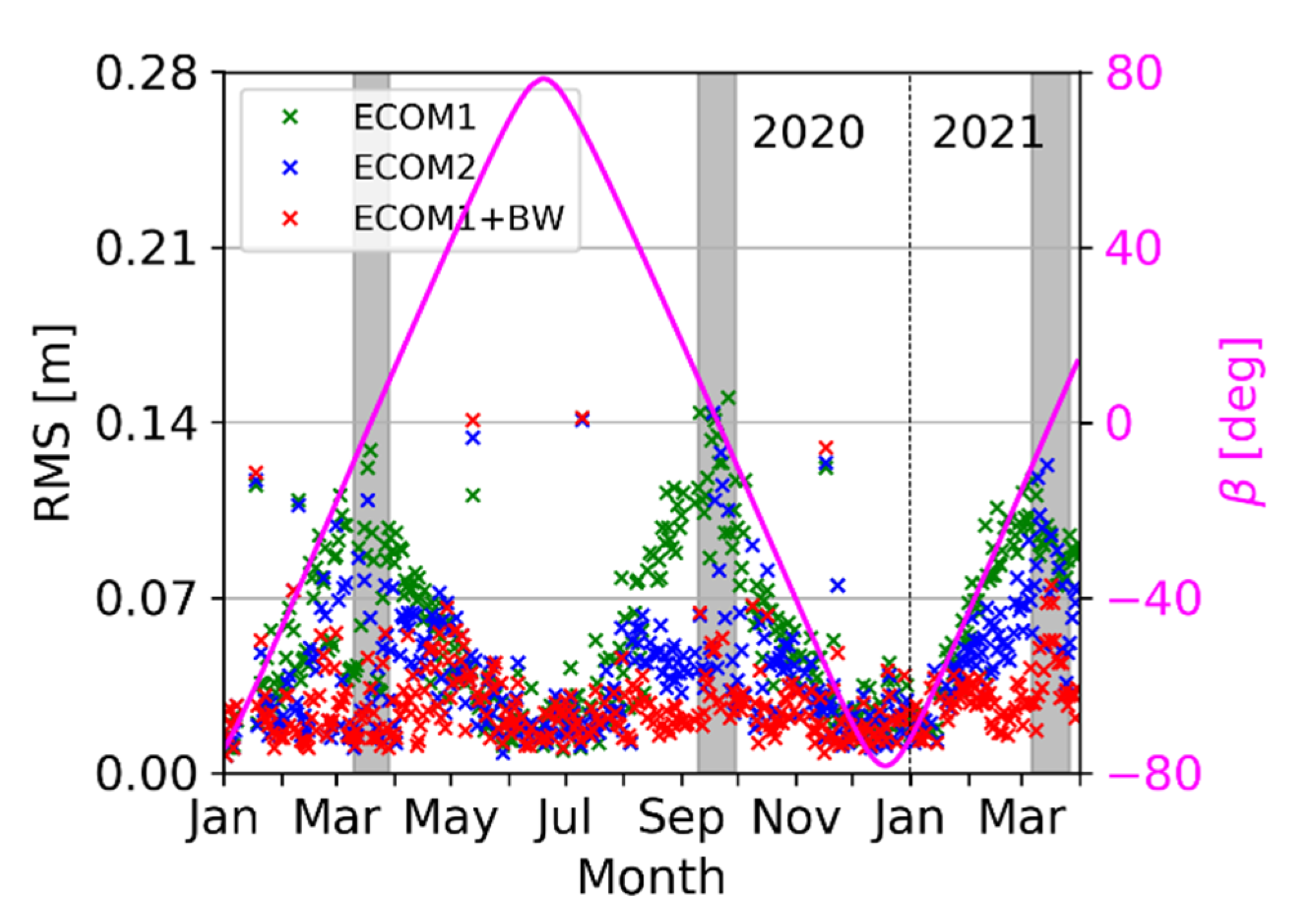
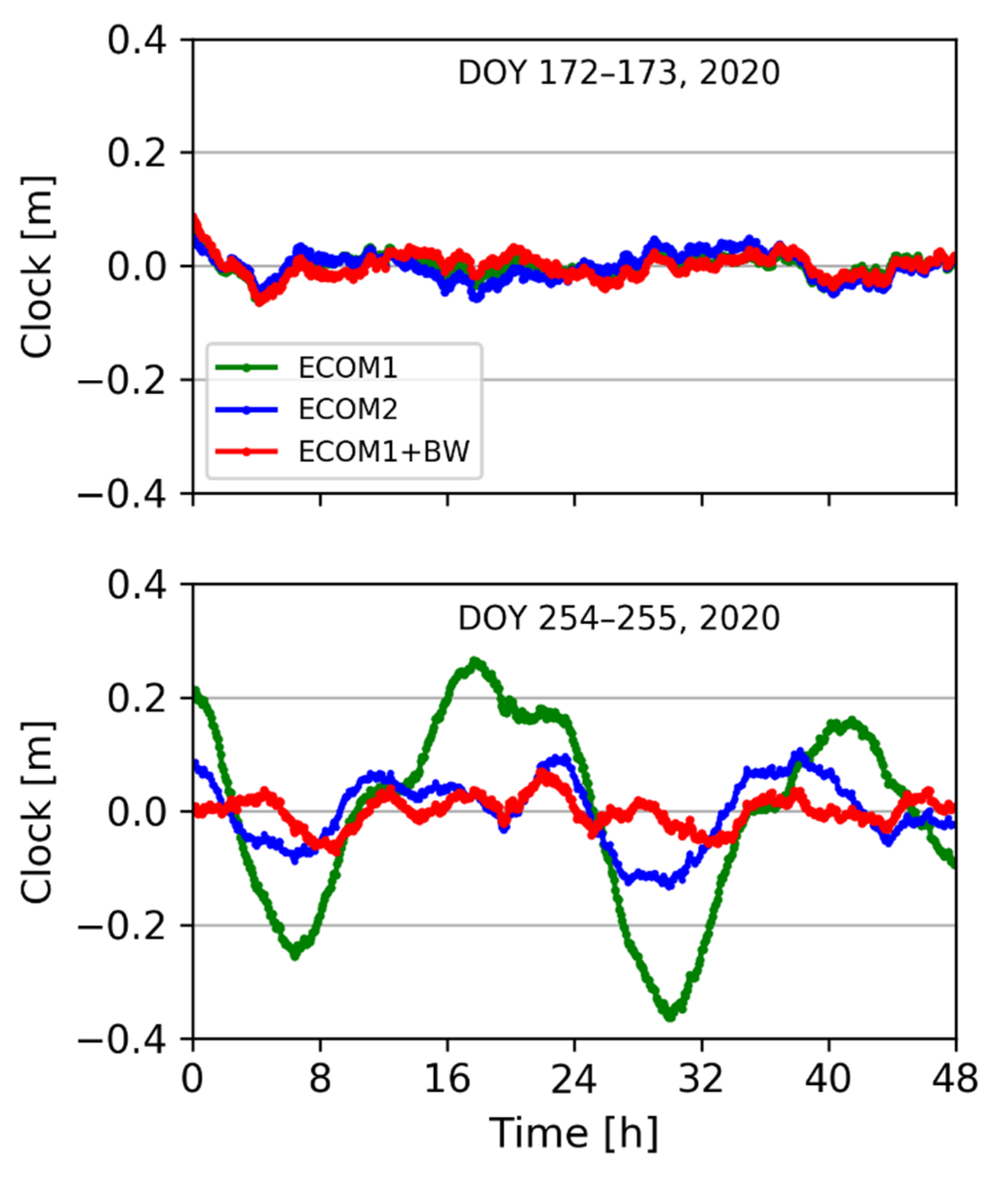
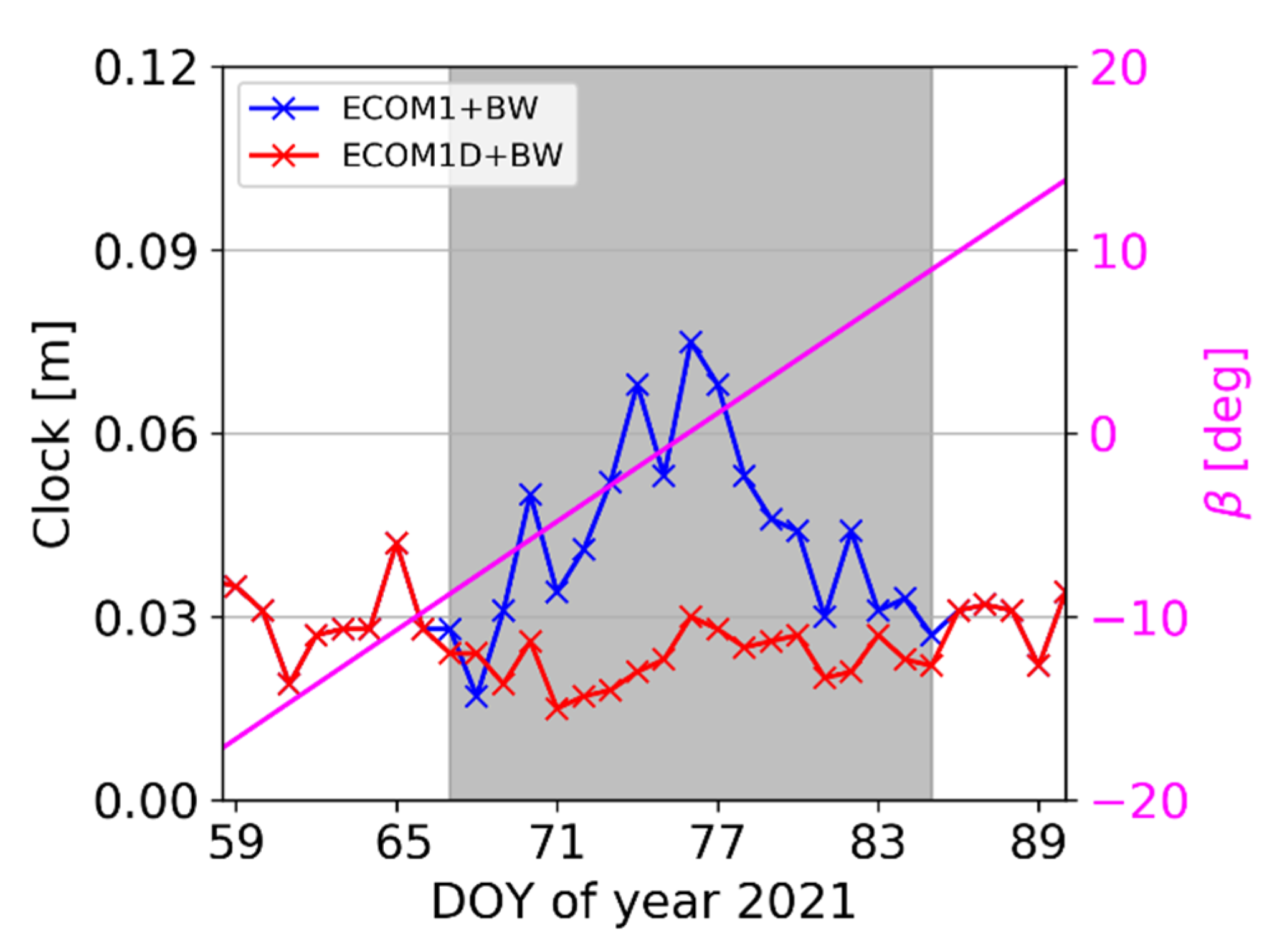
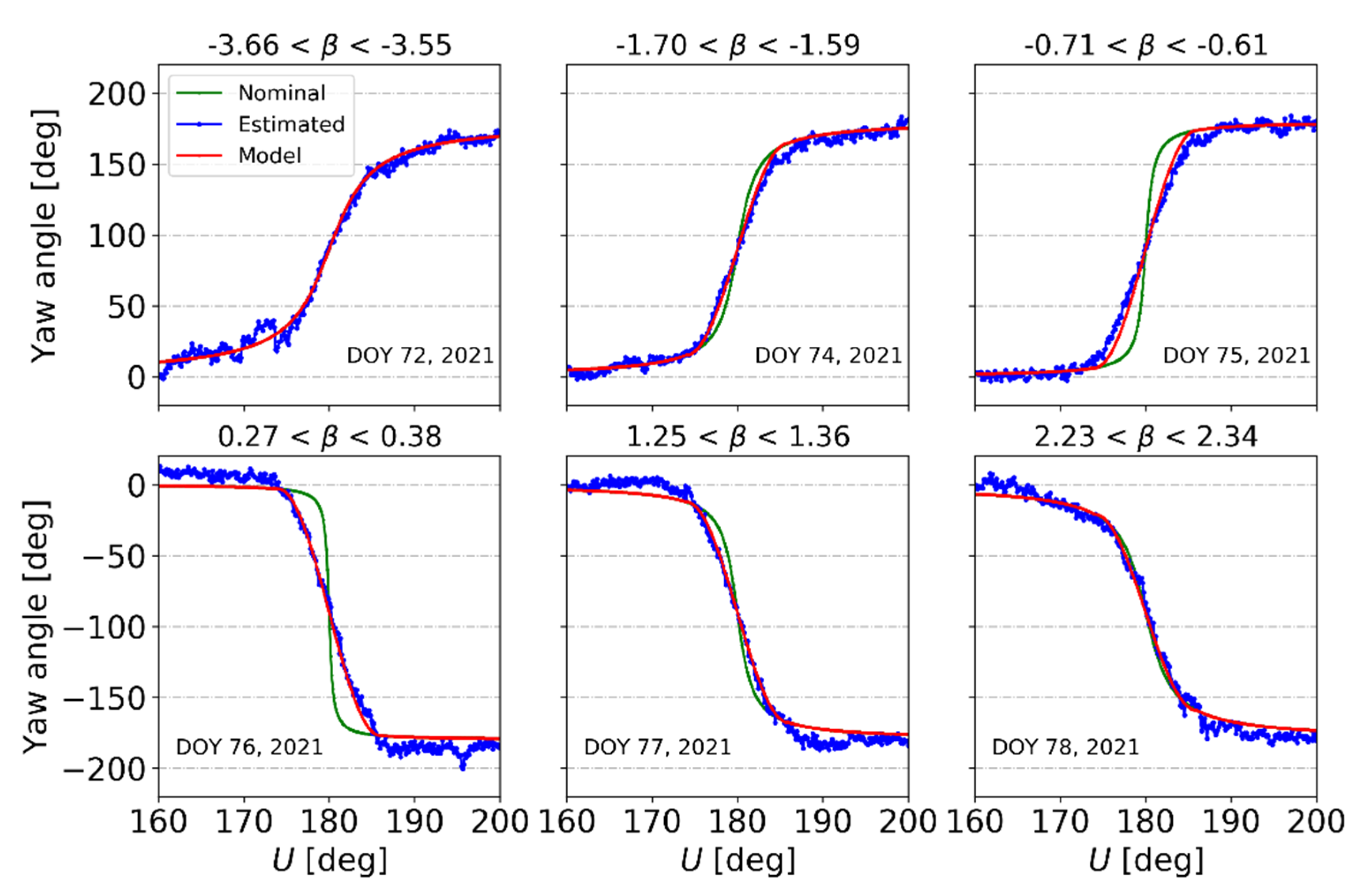
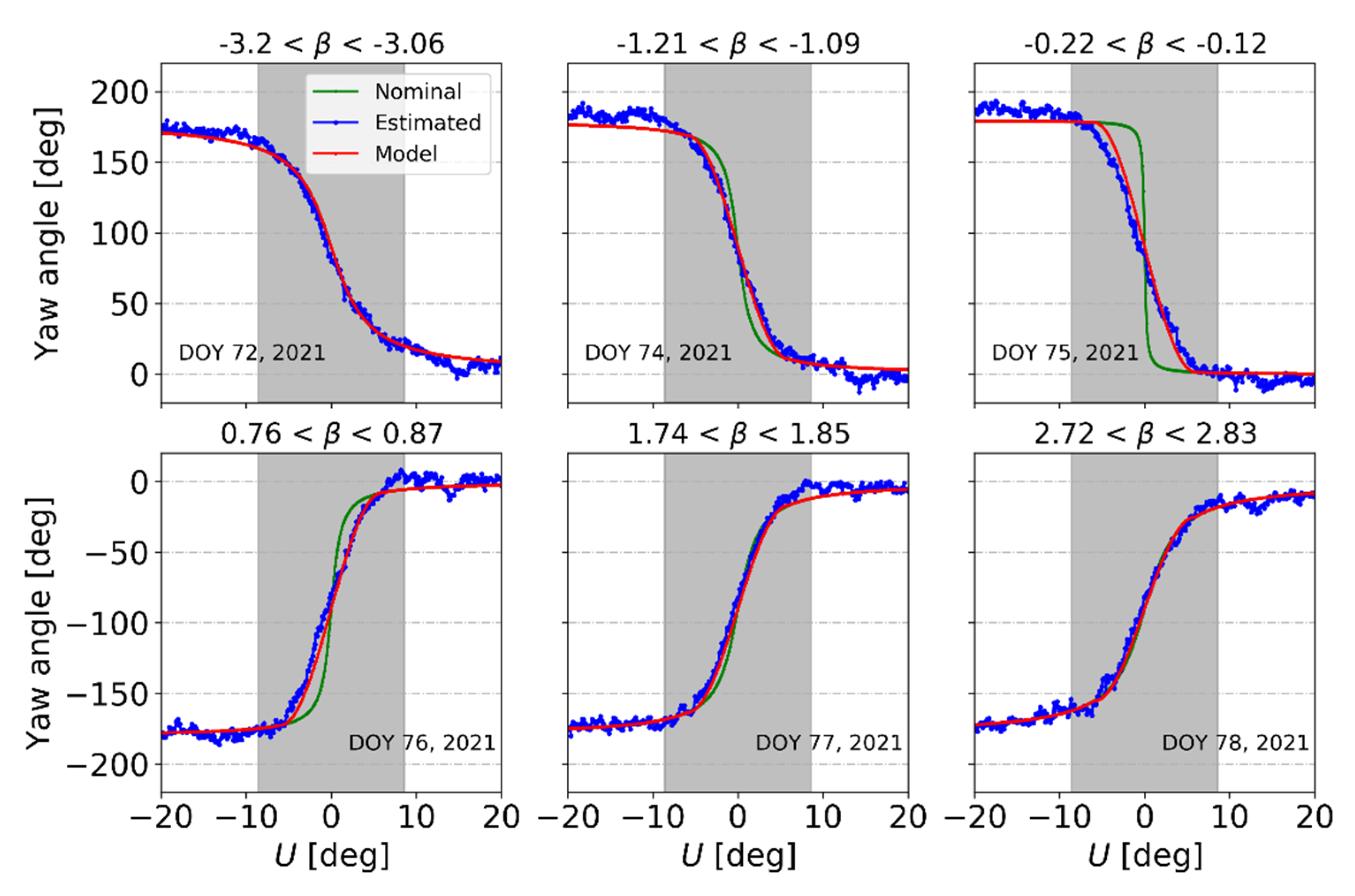
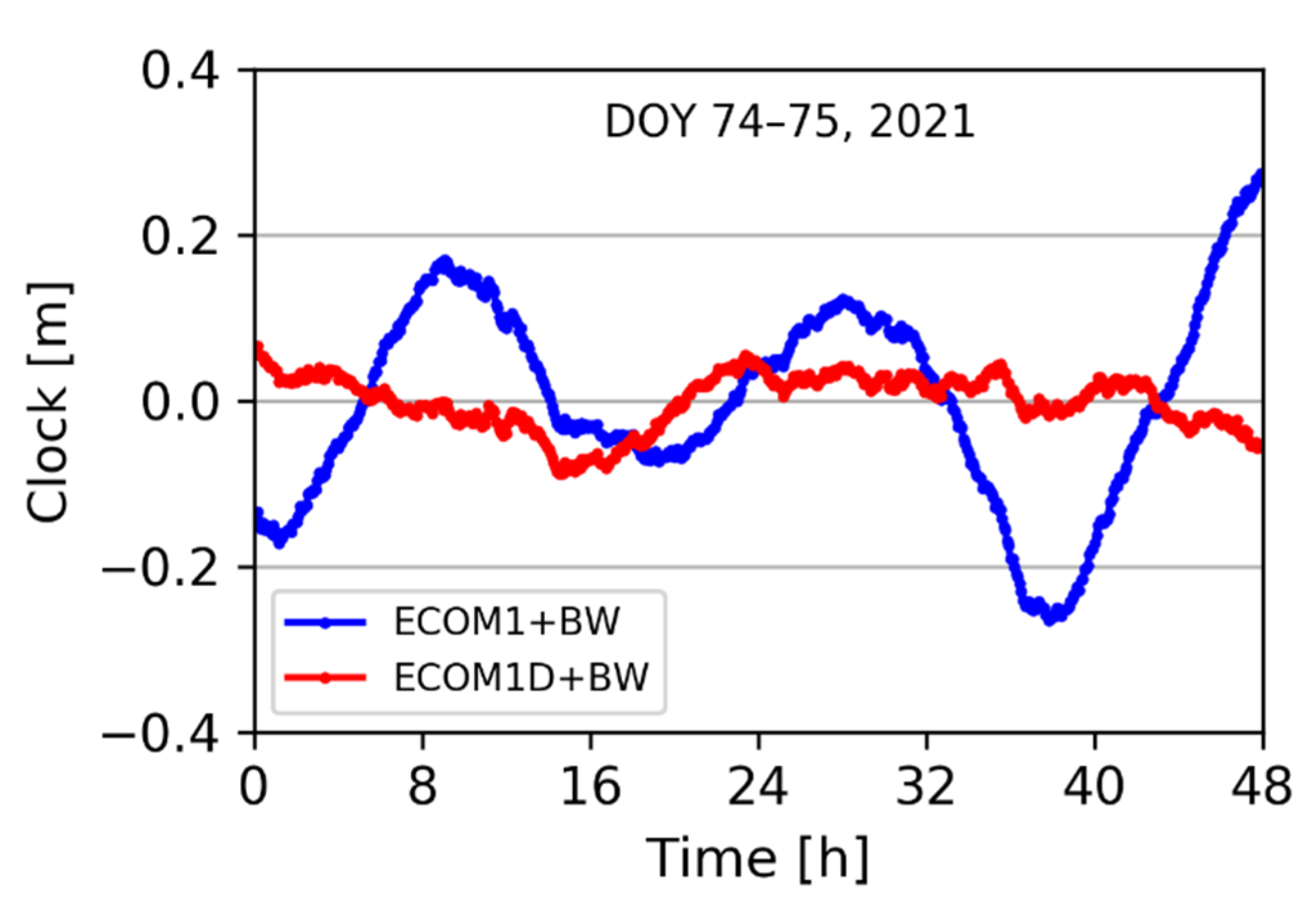
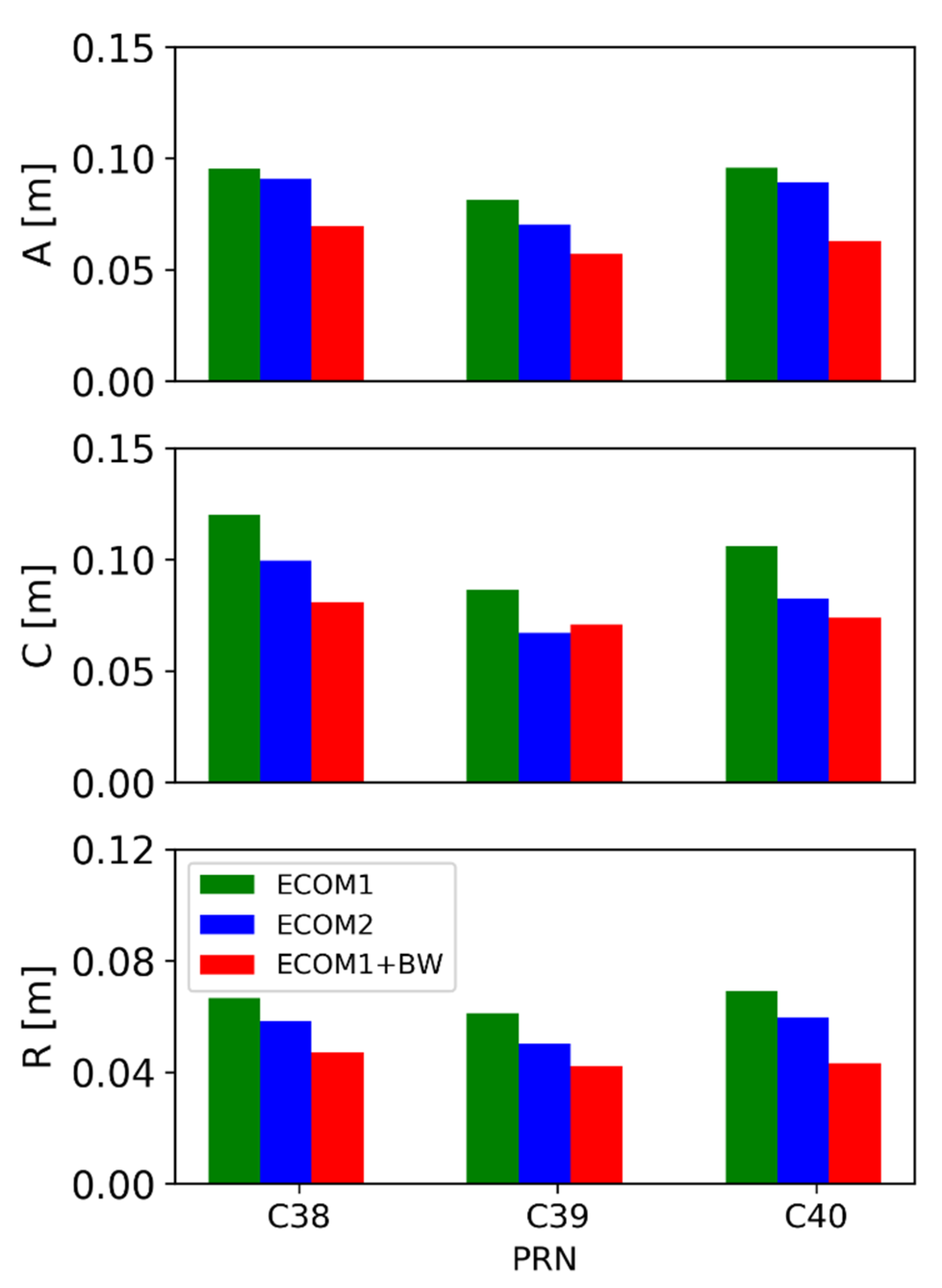
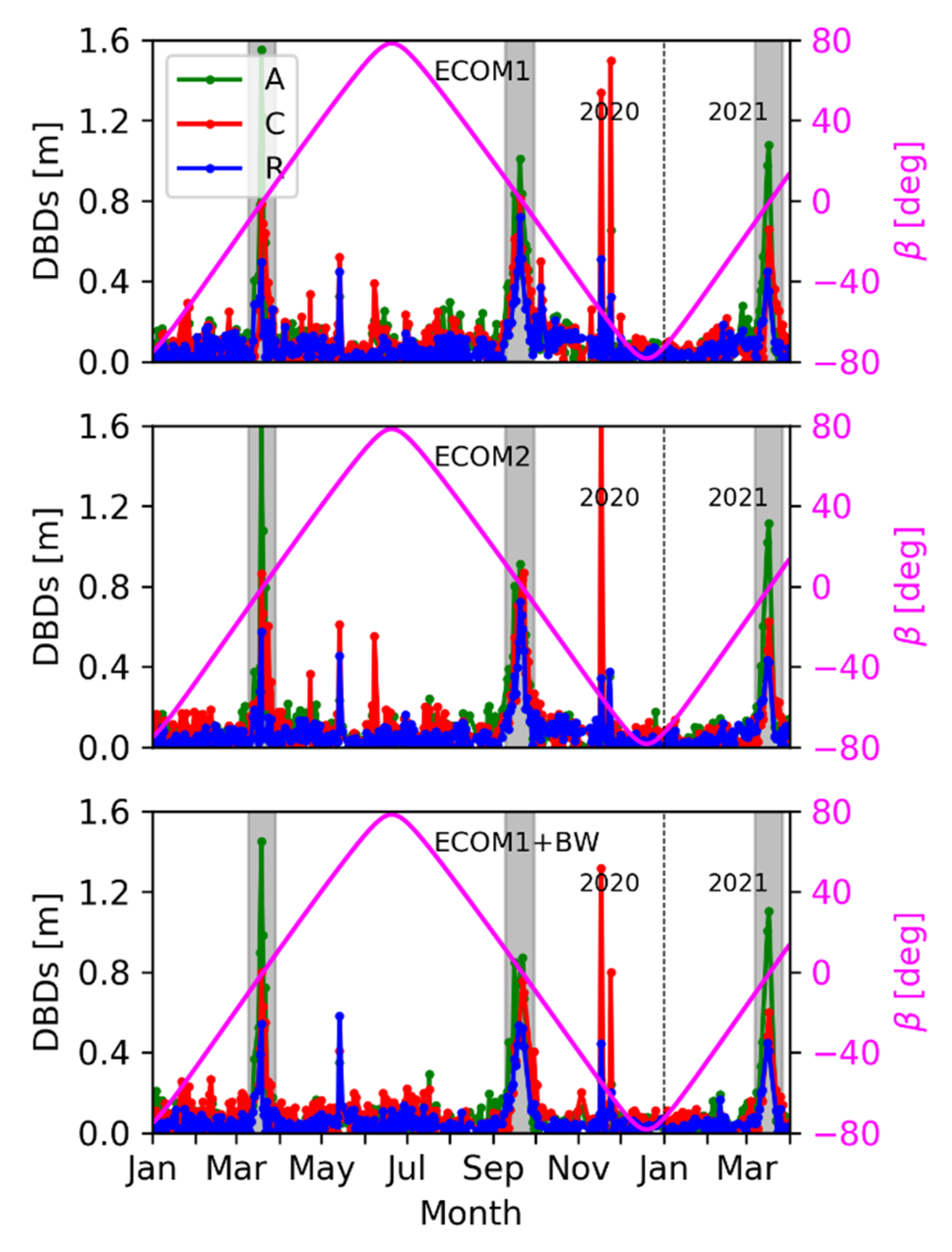
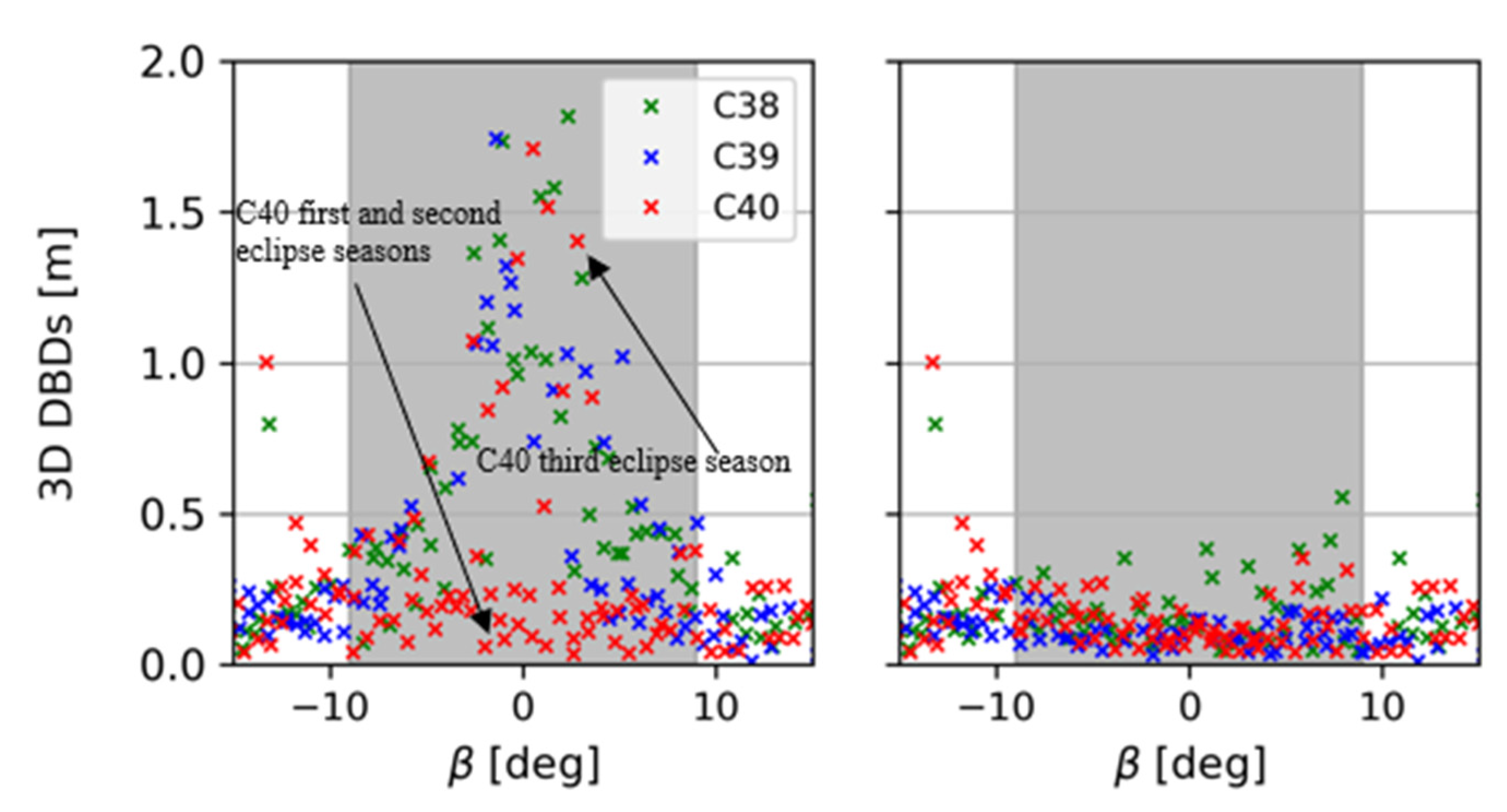
| Panel | Area | |||
|---|---|---|---|---|
| +X | 8.496 | 0.350 | 0 | 0.650 |
| +Z | 20.871 (4.956) | 0.870 | 0 | 0.130 |
| −Z | 20.871 (4.956) | 0.870 | 0 | 0.130 |
| SPs | 17.700 | 0.920 | 0 | 0.080 |
| Item | Description |
|---|---|
| Software | PANDA [30] |
| Orbits | Initial positions and velocities |
| Clocks | Estimated as white noise |
| Elevation cutoff | |
| Sampling | 5 min |
| Weight | Elevation-dependent weighting: |
| Initial standard deviations | 10 mm and 1 m for ionospheric-free combination carrier phase and pseudo-range, respectively |
| Gravitational forces | Earth, Sun/Moon/Planets (DE405), solid earth, ocean and pole tides |
| Relativistic effects | IERS conventions 2010 [31] |
| Attitude model | GPS/Galileo [32], BeiDou-3 IGSOs [33] |
| Antenna thrust | igs_metadata_2081.snx |
| Ambiguity | Fixed for BeiDou-3 IGSOs [34] |
| Receiver ISB | Estimated as constants for each receiver |
| Antenna phase center model | Satellite antenna PCOs and PCVs of GPS L1/L2, Galileo E1/E5a and BeiDou B1I/B3I from igs14_2097.atx. For BeiDou and Galileo receiver antenna, the corrections for GPS L1/L2 are used for the BeiDou B1I/B3I and Galileo E1/E5a as their calibrations are unavailable in the igs14_2097.atx |
| Panel | Area | ||
|---|---|---|---|
| +X | 8.496 | ||
| +Z | 20.871 | ||
| −Z | 20.871 |
| Satellite | ECOM1 | ECOM2 | ECOM1 + BW |
|---|---|---|---|
| C38 | 7.8 | 6.1 | 4.1 |
| C39 | 5.7 | 4.1 | 2.8 |
| C40 | 6.9 | 4.8 | 3.3 |
| SRP Model | C38 | C39 | C40 | |||
|---|---|---|---|---|---|---|
| NE | E | NE | E | NE | E | |
| ECOM1 + BW | 3.9 | 4.2 | 2.6 | 3.3 | 3.1 | 3.8 |
| ECOM1D + BW | - | 4.0 | - | 2.3 | - | 3.5 |
| SRP Model | C38 | C39 | C40 | |||
|---|---|---|---|---|---|---|
| NE | E | NE | E | NE | E | |
| ECOM1 | 19.1 | 67.3 | 14.9 | 58.8 | 17.8 | 90.0 (20.6) |
| ECOM2 | 16.7 | 66.5 | 12.4 | 57.8 | 15.2 | 90.8 (17.6) |
| ECOM1 + BW | 12.1 | 66.3 | 11.0 | 55.3 | 13.3 | 84.1 (16.7) |
| ECOM1D + BW | - | 17.7 | - | 11.3 | - | 13.3 (13.1) |
Publisher’s Note: MDPI stays neutral with regard to jurisdictional claims in published maps and institutional affiliations. |
© 2022 by the authors. Licensee MDPI, Basel, Switzerland. This article is an open access article distributed under the terms and conditions of the Creative Commons Attribution (CC BY) license (https://creativecommons.org/licenses/by/4.0/).
Share and Cite
Xia, F.; Ye, S.; Chen, D.; Tang, L.; Wang, C.; Ge, M.; Neitzel, F. Advancing the Solar Radiation Pressure Model for BeiDou-3 IGSO Satellites. Remote Sens. 2022, 14, 1460. https://doi.org/10.3390/rs14061460
Xia F, Ye S, Chen D, Tang L, Wang C, Ge M, Neitzel F. Advancing the Solar Radiation Pressure Model for BeiDou-3 IGSO Satellites. Remote Sensing. 2022; 14(6):1460. https://doi.org/10.3390/rs14061460
Chicago/Turabian StyleXia, Fengyu, Shirong Ye, Dezhong Chen, Longjiang Tang, Chen Wang, Maorong Ge, and Frank Neitzel. 2022. "Advancing the Solar Radiation Pressure Model for BeiDou-3 IGSO Satellites" Remote Sensing 14, no. 6: 1460. https://doi.org/10.3390/rs14061460
APA StyleXia, F., Ye, S., Chen, D., Tang, L., Wang, C., Ge, M., & Neitzel, F. (2022). Advancing the Solar Radiation Pressure Model for BeiDou-3 IGSO Satellites. Remote Sensing, 14(6), 1460. https://doi.org/10.3390/rs14061460








